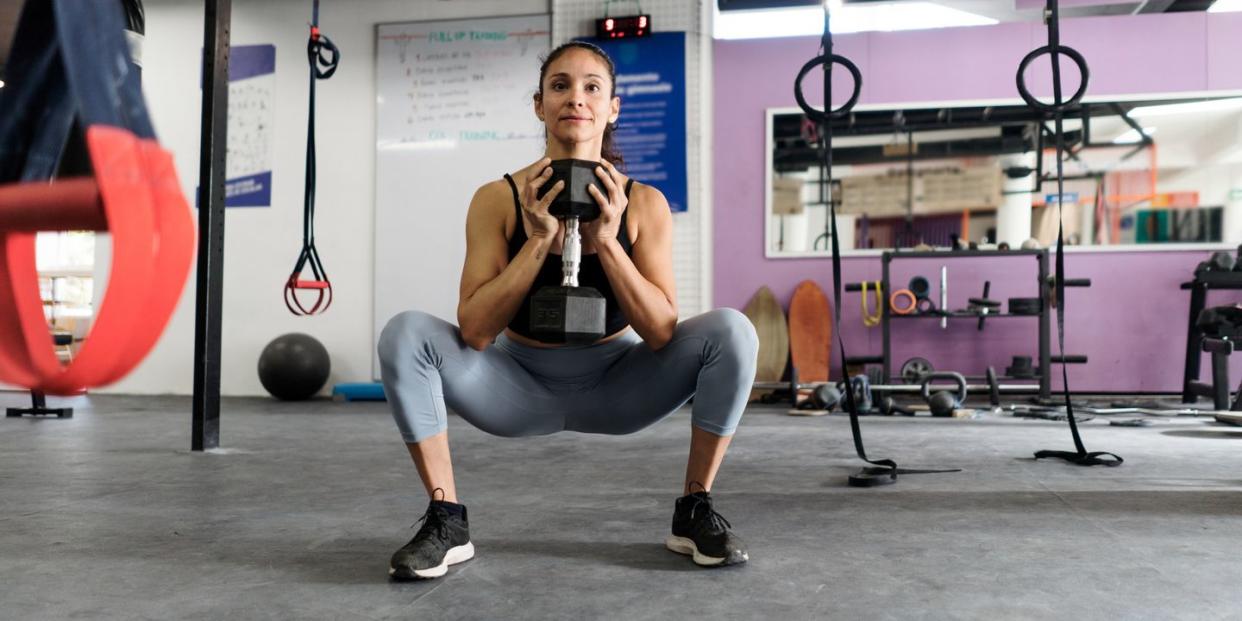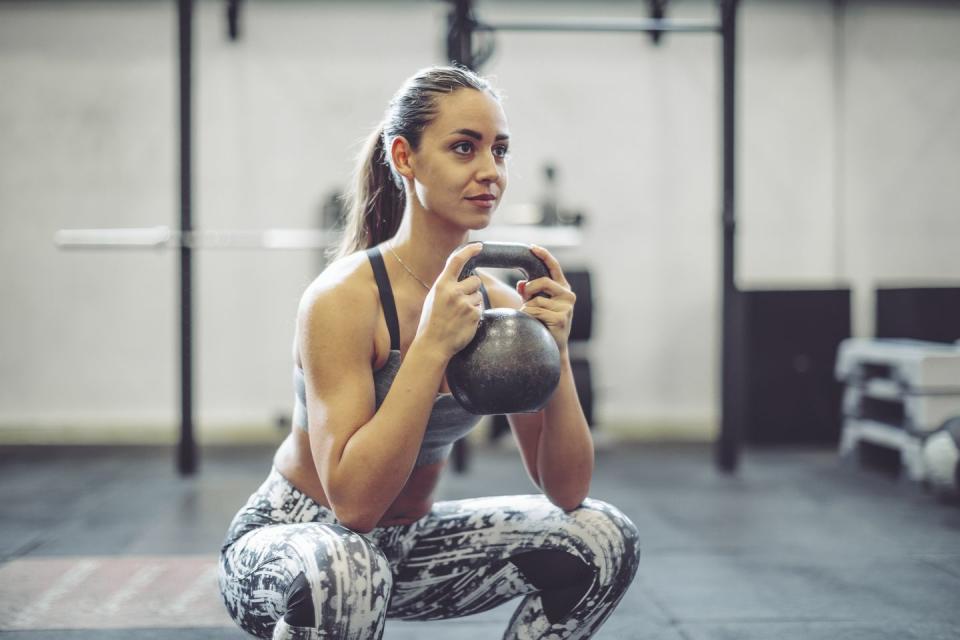When done correctly, this squat challenges your glutes, legs, core, arm and grip

The squat is the undisputed king of all exercises. But with 12.1k of you searching for its captivating cousin, the goblet squat, every month, we had to dive a little deeper into this champion of functional-strength exercises that has moved into a lane all of its own.
‘Primarily, the squat challenges your legs,’ explains Abi Dewberry, master trainer at Best’s Bootcamp. ‘But, executed correctly, it will challenge your glutes, back and core, too.’
A compound exercise, the goblet squat targets multiple muscle groups at the same time (other examples include deadlifts and pull-ups), making it one of the best movements you can add to a full-body fitness regime in the gym as it allows you to get more work done and build overall strength. You'll also be executing one of the fundamental, primal movement patterns critical for everyday life activities.
Read on for your complete guide to this basic but essential move.
What is a goblet squat?
It's a front-loaded squat that's usually done with either dumbbells or kettlebells.

Which muscles does the goblet squat work?
The goblet squat is a full-body exercise that targets your:
Goblet squat form
1. Holding a weight in front of your chest, stand with your feet a little wider than shoulder-width apart, toes slightly turned out. Keep your elbows tucked in and underneath the weight.
‘Lots of people struggle to squat low,’ explains Dewberry. ‘It’s often due to limited hip mobility. If this is you, just step your feet a little wider so you can go deeper.’
2. Keeping your weight in your heels, bend your knees and lower your bum back and down, as if you’re about to sit in a chair.
3. As you lower, engage your core, pull your weight back through your hips and ensure your shoulders don’t round.
Also, beware the rounded back, which will put too much pressure on your shoulders and can cause injury. ‘It’s a common error,’ warns Dewberry. ‘To avoid it, keep your core switched on and feel yourself growing tall through the torso.’
4. When your thighs are parallel with the floor, pause for a second, then drive through your heels to push back up to the starting position.
Goblet squat benefits
1. Decreases the risk of injury
In a traditional barbell squat, the weight is loaded onto your back, putting a lot of tension and pressure on your spine and lower back. Holding the weight in front with a goblet squat allows you to maintain correct, upright posture through the movement and relieves you 0f that spinal pressure.
2. Activates your core
Holding the weight in front of you requires you to engage your core to steady the load.
3. Teaches you proper technique
As the load is in front of you, it's easier to keep your weight in the back of your heels and keep upright, with your spine lengthened. Your elbows tracking between your knees discourages your knees from collapsing inwards. A goblet squat can be seen as a good stepping stone between bodyweight and barbell back squats.
4. Increases grip strength
Holding onto the weight in front requires you to use muscles in your forearm - the flexor digitorum superficialis, flexor digitorum profondus, flexor policus longus and extensor digitorum communis - thereby working your grip, which is associated with overall health.
In 2015, a study revealed a strong correlation between decreased grip strength and increased risk of cardiovascular disease. Researchers found that, 'Each 11-pound decrease in grip strength was linked to a 17% higher risk of dying from heart disease, a 9% higher risk of stroke and a 7% higher risk of heart attack.'
Common goblet squat form mistakes
1. Your shoulders are rolling forward
‘Holding a weight in front of your chest can pull you forward and cause your shoulders to round,’ says Dewberry. Engage your lats and back muscles to stop this happening - keep your chest up.
2. Your weight is too far forward
‘It’s a common mistake to have the weight on the balls of the feet, with your heels lifting off the ground,’ explains Dewberry. ‘This puts emphasis on the quads, not the glutes.’
3. You’re not going low enough
‘Most people don’t reach the optimal depth, only achieving a demi-squat,’ warns Dewberry. At the lowest point, your thighs should be parallel or below parallel to the floor.
Goblet squat progressions
1. Dumbbell front-rack squat
Grab two dumbbells and hold at shoulder level.
Slightly bend the knees and bend down until your knees are at a 90-degree angle, keeping your core embraced and your back straight. Return to standing.
2. Barbell back squat
Once you’re confident using a kettlebell or dumbbell, progress to a barbell.
Set up a barbell on a squat rack, so that it is just below your shoulders when standing up straight.
Step underneath the bar, resting it lightly on your upper traps and shoulders.
With your hands around the bar in an overhand grip, with your knuckles on top, hold the bar just outside of your shoulders.
With your feet just wider than your hips and your toes turned outwards slightly, lift the bar off the rack and onto your back, keeping your chest up and back straight.
Slowly begin to squat down, pushing your hips back and down as if sitting into a chair, without letting your knees roll inwards and keeping your chest up, but allowing your torso to lean forward as needed.
Lower until your hips drop just below your knees, and your knees track in line with your toes, then push through the floor to return to standing. That’s one rep.
3. Overhead squats
Try holding a dumbbell or barbell overhead while you squat. ‘Overhead exercises are a huge challenge for the body. The weight is unsupported so your core and back muscles have to work overtime to stabilise it,’ says Dewberry.
Related stories:
'I did squats every day for 2 weeks; here are 5 surprising things I learned'
Strength training for beginners - a complete guide
Become a member of the Women's Health Collective and get full access to the Women's Health app, available to download on Google Play and the App Store, to get the latest celebrity-inspired workouts and fitness content.
You Might Also Like


